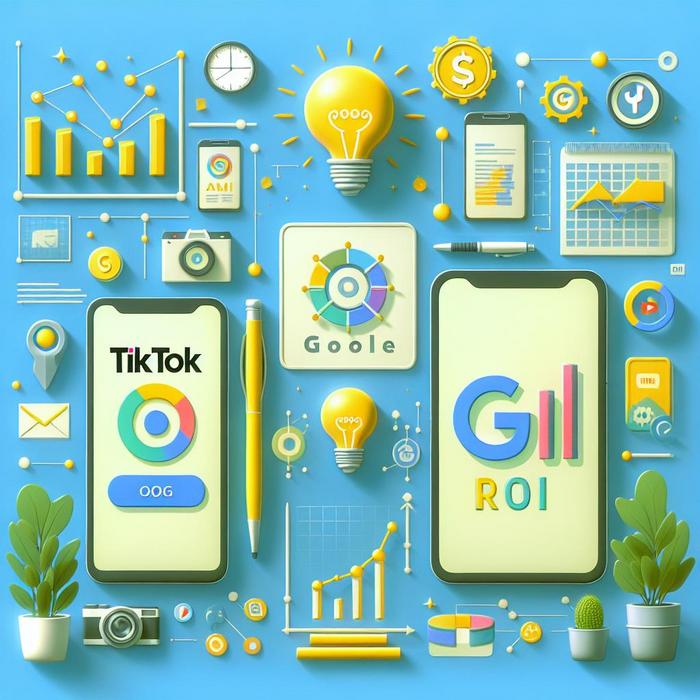TikTok Advertising vs. Google Ads: A Deep Dive into ROI
Experiencing First-Hand: My Journey With Advertising Platforms
Having personally traversed the often-volatile landscape of digital marketing, I can assert from firsthand experience that navigating these waters requires prowess, agility, and a keen understanding of the platform nuances. The need to maximize return on investment (ROI) has led me to work extensively with two major players in the digital advertising world – TikTok and Google.
Examining the differences between TikTok and Google’s advertising approaches, I realized that the key to harnessing the full potential of these platforms lies in recognizing their individual strengths and leveraging them towards a unified business goal. Here, I share my insights from implementing Tailored Campaign Strategies across these platforms.
TikTok Vs Google: Targeting and Engagement
One of the crucial aspects where these platforms diverge is the targeting and engagement strategies. While Google rides on the strength of its robust search engine to target a broader audience, TikTok’s strength lies in its ability to engage younger demographics with immersive content.
- Google: With its intent-based search mechanism, Google targets users with adverts that align with their query, resulting in high relevancy scores. Working with Google’s PPC strategies has allowed me to efficiently direct resources towards high potential prospects, enhancing long-term success.
- TikTok: Meanwhile, TikTok’s foray into the digital advertising realm has brought a new layer of user interaction to the table. Leveraging user-generated content, the platform offers a more immersive advertising experience. Working with TikTok, I’ve tapped into a younger, more engaged user base that has driven a significant return on investment.
It’s worth noting that the right platform for you will largely depend on your target audience and campaign objectives. But the key is understanding how to use these platforms efficiently and, more importantly, optimizing them to your advantage. To this end, I found this comparison quite insightful.
Decoding the Algorithms: Google Vs. TikTok
Another major point of distinction between Google and TikTok lies in their algorithms. Understanding how these algorithms work and using them to their full potential has been instrumental in optimizing my campaigns.
- Google: Google’s algorithm centers around an ad’s relevance to a user’s search query and the quality of the landing page. This facet of Google’s PPC strategies can be vital for businesses seeking long-term success.
- TikTok: TikTok’s algorithm, on the other hand, is user-oriented. It prioritizes user engagement, with a focus on video metrics such as completion rate, likes, shares, and comments.
Both platforms offer unique abilities to reach and engage with audiences, and each can be optimized to deliver improved results. The key to success is understanding these algorithms and aligning them with your business goals. I recommend reading this article for a more detailed comparison of the algorithms.
Reflecting on Strategic Implementation: My Takeaways
In my journey incorporating efficient bidding technologies into these platforms, I found that aligning my marketing strategy with the platform’s strengths could significantly boost the ROI. Whether it was leveraging Google’s wide reach and intent-driven approach or harnessing TikTok’s engaging and immersive content, the key lay in a strategic implementation that took advantage of the platform’s strengths.
Whether you choose Google or TikTok for your advertising needs, understanding your campaign goals, target audience, and platform algorithms can ensure your resources are optimized for the best possible return. Harnessing these insights has made a significant difference in the outcomes of my campaigns, and I believe they can do the same for yours.
For further insights, I highly recommend exploring multi-channel campaign strategies and understanding how a combined approach can boost your results.
As I continue this exploration, I look forward to sharing more insights from my journey, comparing further aspects of these platforms, and shedding light on the most effective strategies for maximizing ROI.
Amid my adventures with efficient Ad deployment, I’ve discovered that advertising on either TikTok or Google is not a surefire way to success – unless cost-effectiveness is meticulously planned. To realize maximum returns on your investment, it becomes essential to understand both platforms’ cost structures and capably navigate through them.
- Google: Google primarily uses a cost-per-click (CPC) model, where ad placement and cost depend on the relevancy and quality of the ad. The competitive nature of ad space on Google means the costs can go high. However, the efficient use of keyword match types and negative keywords can help control costs and improve campaign performance.
- TikTok: Compared to Google Ads, TikTok offers a comparatively cost-effective advertising platform. This, along with the platform’s engaging format, provides a unique advantage for advertisers targeting a younger demographic. However, cost-effectiveness takes time to be achieved on TikTok, as algorithms need adequate data to optimize ad delivery.
In understanding cost-effectiveness, Adroll provides a comprehensive comparison on ad costs across platforms, which has been significantly invaluable in shaping my understanding.
Conversion Focus: A Data-Driven Perspective
Ultimately, what matters most in the realm of digital advertising is how platforms can drive conversions. In reflecting on my past campaigns, I have seen conversion rates heavily influnced by the data-driven strategies embedded within these platforms.
- Google: Google’s strength in driving conversions lies in its precise targeting, delivered through its powerful search mechanism. By efficiently matching user intent with relevant ads, Google often results in higher conversion rates compared to other platforms.
- TikTok: On TikTok, I found that the platform’s strong user engagement channels helped drive significant conversions. This has been particularly effective for my campaigns that were targeted towards brand awareness and engagement.
While Google has traditionally been a strong platform for conversions, TikTok’s high engagement levels indicate a growing potential in driving conversions. This article from Upbeat expands more on these crucial areas of ad conversion.
Future Perspective: An Endless Journey of Optimizing ROI
As I journey further into the ever-evolving world of digital advertising, I remain committed to continuously adapt and learn. With each campaign, I refine my approach, building upon the insights garnered from both Google and TikTok’s advertising strengths.
The adaptability and constant learning involved in efficient campaign management offer infinite opportunities for growth and success. Amid this, being informed and updated with the latest trends and capabilities of different platforms becomes increasingly significant. This piece on the advertising landscape further stresses the importance of staying informed in this ever-changing world of digital advertising.
I am excited to further unravel the potential of these platforms, leverage their strengths, and continue sharing the knowledge and insights I’ve garnered. My ongoing journey to maximize ROI through efficient advertising remains a thrilling endeavour and I look forward to sharing more in future posts.
Experiment, Learn, Repeat: The Path To Success
As a final thought, a word of advice to fellow professionals in strategic roles – digital marketing is an ever-evolving terrain. Success on this path involves relentless experimentation, learning, and iteration. With a strong understanding of platform-specific features and a commitment to learn and adapt, the path to success becomes richly rewarding.
The digital marketing landscape and its associated technologies can offer phenomenal benefits to organizations, if aligned correctly with business goals. So whether it’s Google, TikTok, or any other platform that’s on your horizon, I hope that these insights from my journey guide you towards your path to success.


